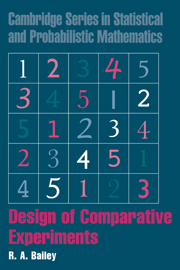Book contents
- Frontmatter
- Contents
- Preface
- 1 Forward look
- 2 Unstructured experiments
- 3 Simple treatment structure
- 4 Blocking
- 5 Factorial treatment structure
- 6 Row–column designs
- 7 Experiments on people and animals
- 8 Small units inside large units
- 9 More about Latin squares
- 10 The calculus of factors
- 11 Incomplete-block designs
- 12 Factorial designs in incomplete blocks
- 13 Fractional factorial designs
- 14 Backward look
- Exercises
- Sources of examples, questions and exercises
- Further reading
- References
- Index
7 - Experiments on people and animals
Published online by Cambridge University Press: 30 October 2009
- Frontmatter
- Contents
- Preface
- 1 Forward look
- 2 Unstructured experiments
- 3 Simple treatment structure
- 4 Blocking
- 5 Factorial treatment structure
- 6 Row–column designs
- 7 Experiments on people and animals
- 8 Small units inside large units
- 9 More about Latin squares
- 10 The calculus of factors
- 11 Incomplete-block designs
- 12 Factorial designs in incomplete blocks
- 13 Fractional factorial designs
- 14 Backward look
- Exercises
- Sources of examples, questions and exercises
- Further reading
- References
- Index
Summary
Introduction
In this chapter we consider experiments on people and animals. Examples are clinical trials, testing educational strategies, psychological experiments, animal nutrition experiments, and trials on ambient conditions in the workplace. There are some issues peculiar to such experiments: these are discussed in Sections 7.2 and 7.7–7.10. On the other hand, the plot structure of such experiments is typically not very complicated, usually being one of those covered in Chapters 6, 4 or 2. These plot structures are specialized to experiments on people and animals in Sections 7.3, 7.4 and 7.5 respectively.
What is an observational unit in such an experiment? Usually it is a person or animal for a set time-period. A measurement may be taken before the experiment starts. This measurement is sometimes called a baseline measurement. It may be used to block the people or animals. It may be used as a covariate in the analysis of the data. Thirdly, the data to be analysed may be the differences between the post-treatment measurement and the baseline measurement.
Sometimes measurements are taken at several different times without changing the treatments. This can be enforced on animals or on hospital patients, but if non-hospitalized patients are asked to come back for measurement too often they may simply drop out of the trial.
What is the experimental unit? It may be a person or animal for the duration of the trial. It may be a group of people or animals for the duration of the trial if treatments can be administered only to whole groups.
- Type
- Chapter
- Information
- Design of Comparative Experiments , pp. 117 - 130Publisher: Cambridge University PressPrint publication year: 2008

